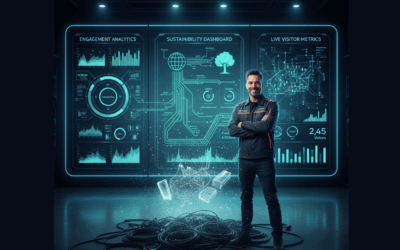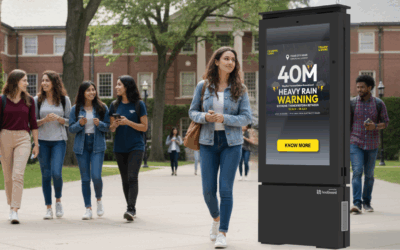The New Definition of “Student Experience”
Thesis: On tomorrow’s campus, personalization is the student experience.
University life is no longer about lectures and libraries alone — it’s about how seamlessly technology connects a student to the opportunities, people, and services that define their journey.
Students today expect their campus to “know” them: what they study, when they’re free, which clubs they might enjoy, and what events matter most. In other words, personalization has become infrastructure.
A 2024 Salesforce Education Report revealed that:
- 72% of students expect digital experiences tailored to their needs.
- 67% say personalization directly increases their sense of belonging.
- 81% engage more when campus communication feels relevant to them.
When streaming platforms and social apps tailor every touchpoint, static bulletin boards feel like relics of a bygone era.

Too Much Information, Too Little Context
Modern campuses are data-rich but context-poor.
There are apps, portals, newsletters, Slack groups, and posters everywhere — yet students still miss deadlines, skip events, and feel disconnected.
Why? Because communication isn’t contextualized to who they are or where they are.
An orientation email can’t help a lost freshman standing outside the wrong building. But an AI-powered kiosk right there can — offering directions, schedules, and reminders relevant to that student, in that moment.
That’s the power of contextual intelligence.

What AI-Powered Kiosks Actually Do
AI-enabled kiosks are not mere digital signage — they’re intelligent nodes connecting every system a student interacts with: LMS, SIS, events, and career portals.
| Capability | What It Does | Example |
| Personalized Recommendations | Learns from student data (major, schedule, interests). | “Hey Priya, the Design Thinking Workshop starts in 10 min nearby.” |
| Smart Wayfinding | Uses AI maps and crowd data to optimize navigation. | “Fastest accessible route to Building D.” |
| Career & Events Matching | Pulls internships or fairs from university APIs. | “3 companies hiring CS grads this week.” |
| Conversational AI Concierge | Answers FAQs and supports 24×7 self-service. | “How do I renew my library card?” |
| Behavioral Insights | Generates anonymized analytics for admins. | “Engagement peaked during Sustainability Week.” |
Each interaction fuels a feedback loop — AI learns, adapts, and improves engagement over time.

Why It Matters: The Human Layer Beneath the Tech
The first week on campus can be overwhelming.
Students are navigating new systems, buildings, and expectations — often in isolation.
AI kiosks turn campus spaces into helpful companions, bridging that human gap. For example:
- A kiosk near the library might say, “Need a quiet space? Study rooms available on Floor 3.”
- Outside the counseling center: “Join today’s de-stress yoga workshop at noon.”
- Near dorms: “Tonight’s football game is free for freshmen.”
Each message meets a student where they are, not where the system thinks they should be.
It’s empathy at scale.

Integration: Turning Disparate Systems into a Single Experience
AI kiosks integrate seamlessly with existing campus infrastructure:
| System | Result |
| Learning Management (LMS) | Suggests assignments or workshops from enrolled courses. |
| Student Information (SIS) | Tailors notifications by department or semester. |
| Event Management | Displays real-time events and RSVPs. |
| Career Services | Surfaces fairs and recruiter visits by major. |
| Facilities & Access | Books labs, rooms, and resources with one tap. |
This interoperability makes kiosks the front door to every digital service — intuitive for students, efficient for IT.

The ROI Equation for IT Leaders
Universities today spend thousands annually on repetitive helpdesk queries, print materials, and orientation staffing. AI kiosks compress all that cost into an interactive, data-driven layer.
Sample ROI Model (per kiosk):
| Metric | Value | Notes |
| Student Interactions / month | 2,000 | Orientation & ongoing support |
| Reduced helpdesk load | –25% | Fewer “where do I…?” queries |
| Print & signage savings | –40% | Transition to digital content |
| Event attendance uplift | +30–45% | Through personalized promotion |
| Payback period | 18–24 months | Based on hardware + SaaS costs |
Universities implementing networked kiosks report 30–40% higher event participation and measurable improvements in student satisfaction scores — key metrics tied directly to retention and funding outcomes.

Data Ethics and “Privacy by Design”
AI on campus must earn trust. That’s why modern kiosk systems embed Privacy by Design principles:
- Transparency: Always show what data is being used.
- Consent-Driven Personalization: Opt-in for tailored experiences.
- Anonymized Analytics: No personally identifiable data shared.
- Bias Mitigation: AI models trained on diverse student data sets.
This ensures personalization never crosses into surveillance — a key compliance factor under FERPA, GDPR, and CCPA.

Inclusivity and Accessibility by Default
Personalization must serve every student.
AI kiosks can be configured for:
- Voice and text interfaces for visually impaired users.
- Multilingual support for international students.
- Real-time captioning for hearing-impaired interactions.
Example: University of Melbourne’s pilot kiosks now auto-switch to Mandarin or Hindi when international IDs are scanned — reducing orientation confusion by 70%.
That’s personalization as inclusion, not privilege.

Building Connection and Belonging
AI kiosks don’t just serve — they celebrate.
They can greet students by name, highlight cultural festivals, promote mental-health workshops, or feature club spotlights.
Every personalized interaction says: “You belong here.”
“AI kiosks aren’t replacing human connection — they’re scaling it.”
— Satya Shahade, CEO, HootBoard
That’s the emotional return universities often overlook when they think of “technology adoption.”

The Future: From Smart Screens to Sentient Campuses
The future campus will be aware, adaptive, and anticipatory.
AI kiosks will soon:
- Recognize time-of-day patterns and adjust content dynamically.
- Sync with student wearables to push wellness or study break reminders.
- Predict crowd flow and reroute navigation accordingly.
- Integrate generative AI to summarize events, lectures, or campus news on demand.
This is the beginning of a living campus ecosystem — where physical and digital experiences merge seamlessly.

A Smarter Campus Is a More Human One
Technology should simplify, not overwhelm.
AI-powered kiosks do just that — translating campus complexity into personalized clarity.
They reduce burden on staff, empower IT with actionable data, and make every student feel seen.
Because in the attention-deficient world of higher education, the institutions that personalize will be the ones students remember.
On tomorrow’s campus, personalization is the student experience.




